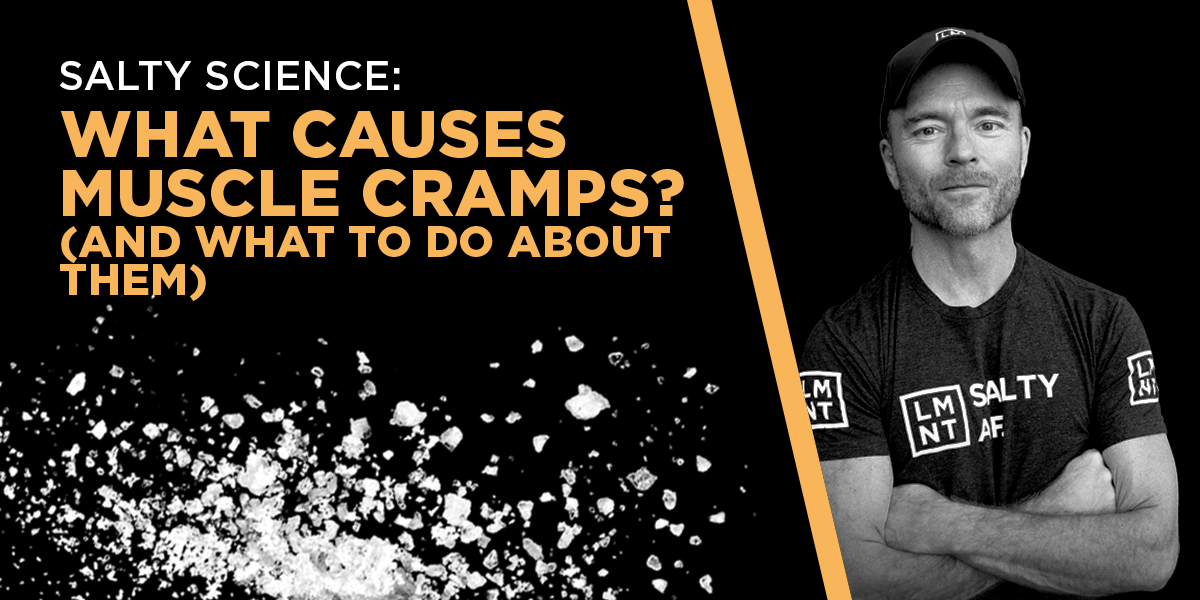Nothing gets your attention like a muscle cramp. It comes on quickly and hurts like hell.
Muscle cramps often occur in and around exercise, but not always. They can happen anytime. For example, many people get calf cramps in the middle of the night.
What causes muscle cramps? Is it dehydration, electrolyte deficiency, muscle fatigue, drugs, or neuromuscular misfiring?
These are all potential causes. There’s lots of debate on this topic, but depending on the situation, different things can cause this painful symptom.
For instance, if a group of athletes cramps after sweaty exercise, it’s probably a sodium problem. (When athletes drink salty water, the cramps diminish). But if a person is properly hydrated and STILL cramping, we have to look elsewhere.
We’ll be nerding out on muscle cramps today, but it’s a practical nerd-out session. You’ll not only learn what causes muscle cramps but also what to do about them.
What Is A Muscle Cramp?
A muscle cramp is a sudden, painful contraction of a muscle. These painful contractions can last from several seconds to many minutes. Aftereffects such as muscle stiffness or soreness can last for days.
The muscle groups that cramp most frequently are located in the legs, feet, hands, and abdominals. About 80% of cramps occur in the calf. Exactly why cramps love calves, however, isn’t clear.
Muscle cramps don’t only affect the muscles, but the full body. They can even impact your emotional state.
It’s hard to predict when a muscle cramp is coming. The onset is rapid and the warning signs are vague and unreliable.
Nonetheless, researchers have pinned down a handful of muscle cramp risk factors. Let’s explore these risk factors before reviewing more specific causes.
Risk Factors For Muscle Cramps
Certain diets and activities are more conducive to muscle cramps than others. Even genetics may be a factor in muscle cramps.
In the nutrition category, the keto diet is a risk factor for muscle cramps. Muscle cramps are part of the constellation of symptoms—headaches, cramps, brain fog, fatigue, and constipation—called keto flu.
Why are keto folks more likely to cramp? Because keto dieters tend to be low on electrolytes, which are crucial for muscle function. More on this soon.
Tiring exercise is another risk factor for muscle cramps. As muscles fatigue, they appear to become more prone to cramping.
In 82 marathon runners, for instance, all cramps occurred after about 15 miles of running. None occurred before, presumably because muscles were less fatigued.
Another analysis on 1300 marathon runners also found fatigue to be a risk factor for cramps. The runners that trained harder than normal were more likely to cramp up.
The risk for muscle cramps rises if the athlete exercises in the heat. The hotter the training session, the more sodium is lost through sweat, the more likely the athlete will cramp.
This has been shown in several populations. American football players, for instance, got 95% of their cramps when the weather was hot. The largest chunk of these cramps occurred during the first week of training camp when the weather was hottest and the athletes were most out of shape.
I’m not surprised sweat loss is a risk factor. Athletes can lose up to 7 grams of sodium per day sweating in warm climates. That level of depletion is bound to cause cramping if the sodium isn’t replaced.
Along with keto, exercise, and sweat loss, other risk factors for muscle cramps include:
- Age
- BMI
- Underlying chronic disease (cardiovascular disease, cancer, kidney disease, etc.)
- Allergies
- Medication use
- History of injury
- Family history of muscle cramps
Now let’s drill down another layer and see what might be causing muscle cramps.
What Causes Muscle Cramps?
Scientists don’t know precisely what causes muscle cramps. There are two prevailing theories:
- Cramps are due to a neurological disturbance
- Cramps are caused by improper hydration
The second theory, however, needs to be broken into two parts: a water part and an electrolyte part. So that’s a total of three potential causes. Let’s run through them.
Theory #1: Impaired neuromuscular control
In the 1980s, researchers realized that exercise-associated muscle cramps didn’t always happen in the context of heavy sweat loss. They began looking for other explanations.
One theory was that muscle fatigue triggers a series of events that impairs motor neurons. (Motor neurons are brain cells that control voluntary actions). This impairment jogs the central nervous system, which responds by activating (cramping) the muscle.
Some data on athletes support the neuromuscular theory. When you block the motor neurons in athletes prone to cramps, it takes a greater electrical stimulation to induce a cramp. So clearly the motor neurons are involved.
The theory, however, has holes. If muscular fatigue triggers this problem, why do only a small percentage of marathon runners develop cramps? They’re all getting fatigued. Only a few are cramping.
Theory #2: Dehydration
Muscle cramps are a well-documented dehydration symptom. But is dehydration (net water loss) a meaningful cause of muscle cramps during exercise?
Most hydration websites say yes. According to a 2016 review on hydration misinformation, about 98% of websites say dehydration causes exercise-associated muscle cramping.
But the truth is, there’s little evidence for this theory. One study showed that even significant hypohydration (over 5% of body water lost) did not increase the frequency of muscle cramping.
The real problem is overhydration. To prevent dehydration, many athletes drink beyond their thirst, diluting blood sodium levels. This can cause cramping.
Theory #3: Electrolyte imbalances
Electrolytes are minerals that conduct electricity in your nervous system and keep your bodily fluids balanced. Relevant here: electrolytes are essential for muscle contraction and relaxation.
Deficiencies in the following electrolytes are the most common for causing cramps:
- Sodium
- Potassium
- Magnesium
- Calcium
Low sodium is probably the biggest driver of muscle cramping during exercise. If sodium lost through sweat isn’t replaced—and if the athlete over-hydrates with plain water—cramps are likely to occur.
The earliest evidence for low sodium causing muscle cramps comes from sweaty, crampy construction and steel mill workers in the 1920s. When these workers were given salt supplements, the incidence of cramps decreased.
More recent research found that football players with higher sodium concentrations in sweat were more likely to cramp. Kidney patients on dialysis also have more cramps when they’re given low-sodium fluids. When electrolytes are normalized, the cramps diminish.
Finally, low sodium explains many keto-related muscle cramps. Keto folks not only have lower dietary intakes of sodium, but they also excrete more sodium through urine. It’s a formula for electrolyte deficiency.
Natural Remedies for Muscle Cramps
One of the best-known cramp treatments is a drug called quinine. But I don’t recommend quinine. Too many serious side effects.
I recommend a more natural approach, with a focus on recovery and hydration. Here are my tips:
Exercise smart
Muscle fatigue is a risk factor for muscle cramping. This doesn’t mean you shouldn’t tire out your muscles. (That’s how you get stronger). It just means that you should be wary of pushing your limits. Adequate recovery time between training sessions will also decrease your risk of muscle injury.
Stretching, massage, and heat
Some research suggests that shorter stretch times are a risk factor for muscle cramps. Another study found no link.
I don’t know about this one. I’m a fan of dynamic stretching (aka, moving around in different positions) over static stretching. Dynamic stretching builds mobility along with flexibility.
Heat and massage may also alleviate cramps. This could be a placebo effect, but getting a massage can’t hurt. It’s all upside.
Increase dietary electrolytes
Whenever you can, consume electrolyte-rich foods to prevent deficiencies and cramping.
- For potassium: green leafies, avocados, meat, and sweet potatoes
- For magnesium: green leafies, nuts, and legumes
- For calcium: dairy, cruciferous vegetables, and bones
- For sodium: the salt shaker
If you’re on a keto diet, you’ll have to work extra hard to reach the evidence-based targets of 4–6 grams sodium, 3.5–5 grams potassium, and 400–600 mg magnesium without eating carbs. This means lots of spinach, kale, and salt. Sauteed kale with salt is delicious folks.
Hydrate with electrolyte water
To prevent cramps, add electrolytes to your water when you rehydrate. Consider the evidence:
- Salt supplements decreased cramps in early 20th century workers.
- Men drinking an oral rehydration solution (with electrolytes and fluids). after hot exercise were less likely to cramp than men drinking plain water.
- Football players who drank electrolyte-enhanced sports drinks developed fewer cramps than those who drank plain water.
- Drinking pickle juice (high in sodium) prevents muscle cramps in dehydrated people.
But you don’t have to glug pickle juice if that doesn’t sound appetizing to you. Just add salt to your water, or mix in a stick of Drink LMNT. Sip to thirst throughout the day. Your chance of cramping just decreased dramatically.

